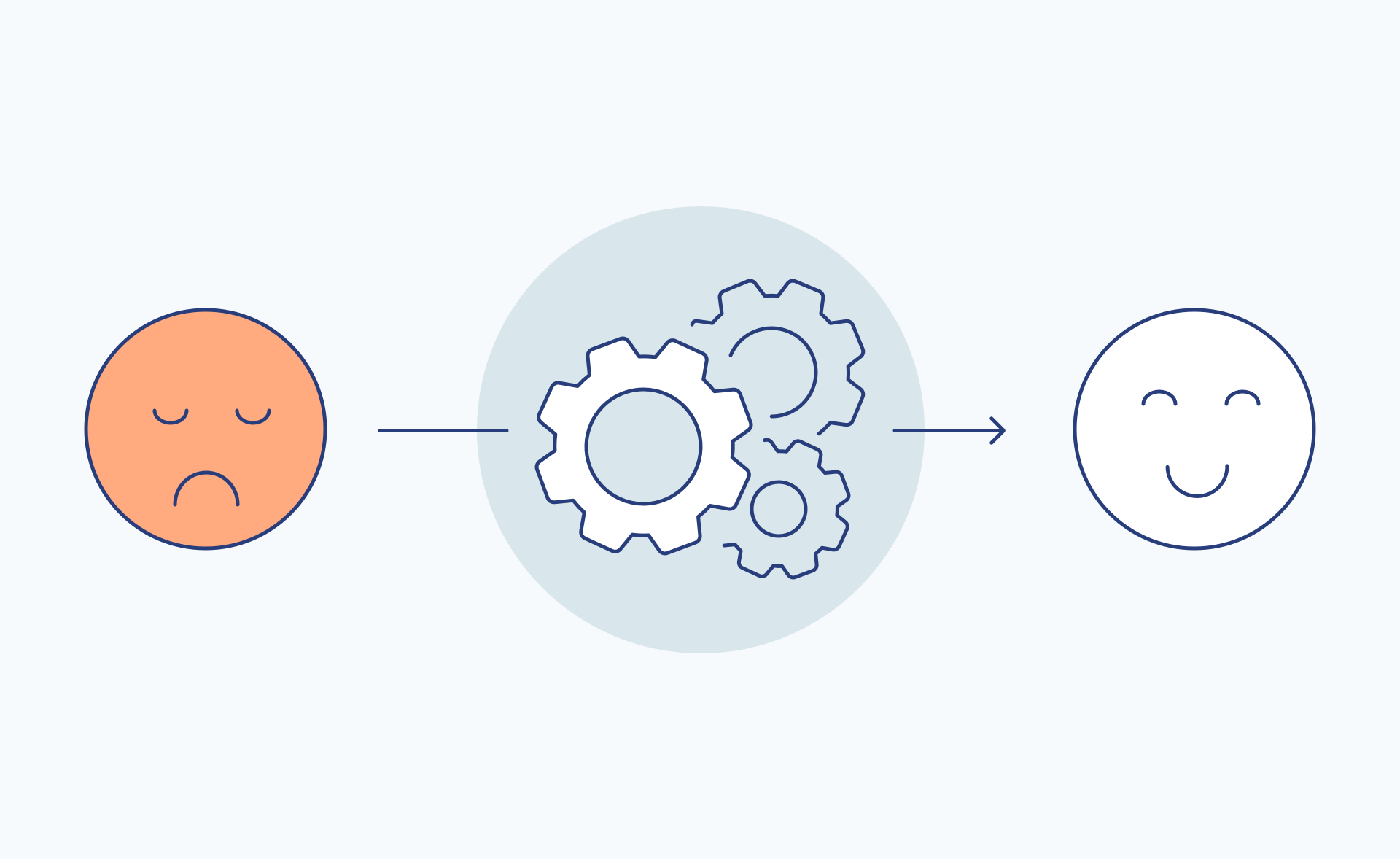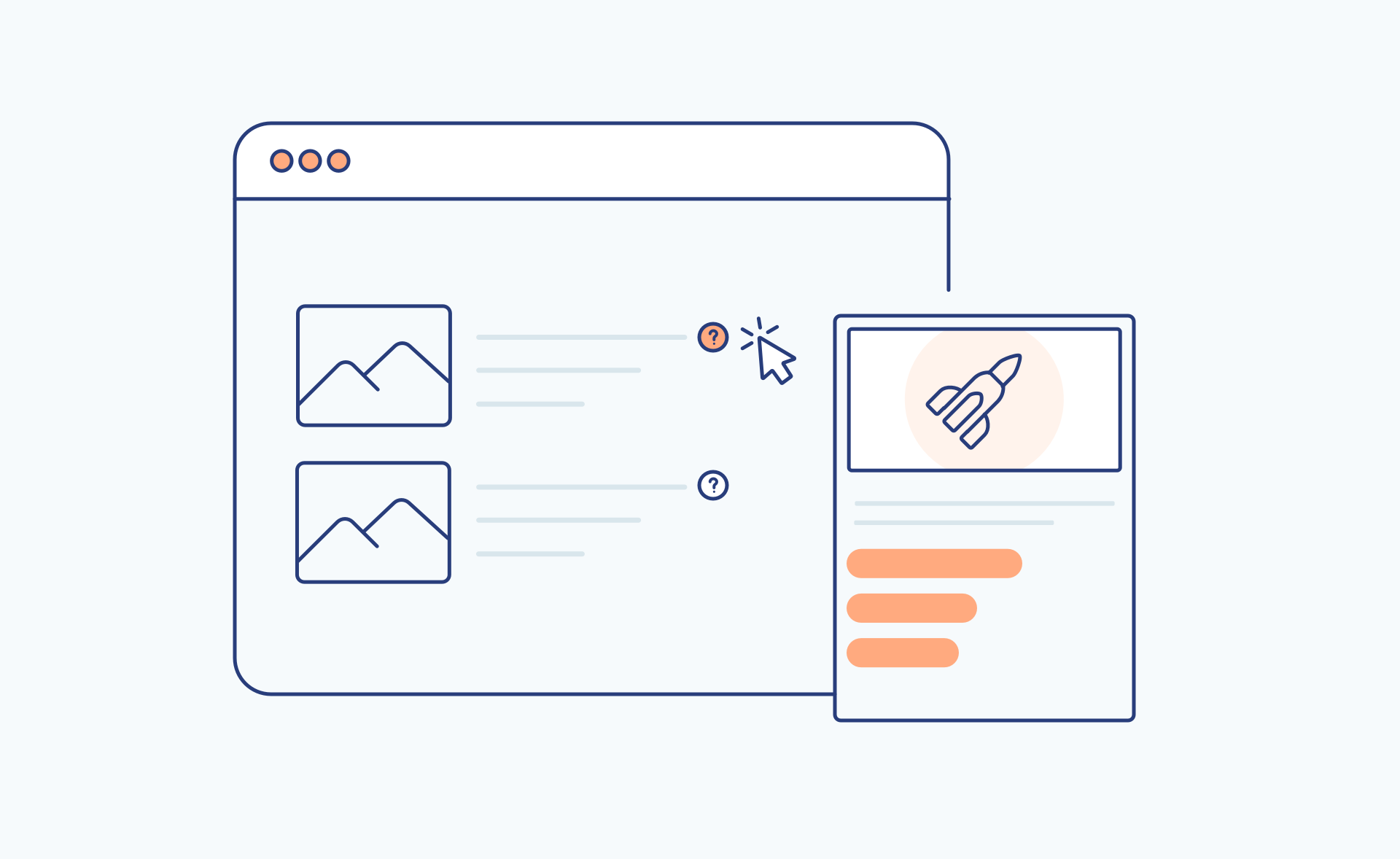Every company fights to earn their customers’ loyalty because it’s five times more expensive to acquire a new customer than it is to retain one. The key to ongoing loyalty? Customer satisfaction.
Most companies measure customer satisfaction with a CSAT score. The higher the score, the more satisfied their customers are. However, the process for increasing a CSAT score is challenging and requires a coordinated effort.
In this roadmap, we’ll show you eight specific ways you can boost your CSAT score.
What’s the fastest way to improve your CSAT?
Make self-serve support the channel where customers can self-solve issues and achieve success on their own. Unlike traditional self-serve support tools, Stonly enables you to deliver adaptive, contextual help right when it matters. Schedule a demo to see how.
1. Measure your CSAT and set a goal
Customer satisfaction (CSAT) is one of the most common metrics used in customer service today. And to improve it, you first need a baseline measurement. To measure your CSAT, simply ask your customers one question: How would you rate your satisfaction with [blank]?
Most companies give customers the option to respond by selecting an option on a five-point scale, ranging from “Very Dissatisfied” to “Very Satisfied.” To calculate your CSAT score, add up your “Satisfied” and “Very Satisfied” responses, divide it by your total response volume, and multiply by 100 to get a percentage.
CSAT scores can vary by industry, but an average score across most industries is typically between 70-80% .
When it comes to measuring your CSAT, it’s also important to consider a couple key logistics:
- When should you ask your customers to rate their satisfaction? For most companies, it’s right after a customer has an interaction with customer support. That way, the experience is still fresh in their minds. But be mindful about how often you ask your customers for a CSAT score. You don’t want to overwhelm them.
- How do you gather their feedback? Typically, most companies will ask customers to rate their satisfaction with a survey. The survey may arrive via email or text, or it might be in a popup on a website or in an app.
If you don’t already have a CSAT goal, set one now. Make it ambitious, but realistic. Without a clear target to aim for, it will be difficult to motivate your support team and to celebrate progress.
Related post: What is an NPS Program & How to Build One? [Detailed Guide]
2. Analyze your CSAT data to find opportunities
CSAT surveys can provide you with a wealth of data on your customers’ expectations and the customer experience you’ve created. But it’s up to you to put this data to work and generate lasting value from the insights.
Determine which segments are sinking your CSAT score
When a customer indicates dissatisfaction, it’s not always immediately clear why. To find the root cause and identify ways to improve your CSAT score, you’ll need to think creatively and analyze your CSAT data from multiple angles:
- How does CSAT compare across our different customer segments? What about different product segments?
- What’s our CSAT score for each of our support channels?
- What are the common drivers of low CSAT? This might include a lack of empathy with customers, slow response times, a confusing product, etc.
- How does CSAT correlate with other metrics you track, such as first contact resolution or first reply time?
That last question can be particularly powerful because the answers will give you insight into the levers you can pull to improve customer satisfaction across the board. For instance, if your dissatisfied customers correlate strongly with lower first reply times, you’ve got a pretty clear argument for taking action to reduce reply times.
Shape future interactions with each customer
The second way to leverage your CSAT data to increase your CSAT score is by using it to shape future interactions with your customers. That may sound complicated, but it’s quite simple. When a customer completes a CSAT survey, attach that data and score to their account in your help desk or CRM. Make it easily visible, so that the next time the customer reaches out for assistance your support team can quickly grasp the history of past interactions and tailor their approach.
3. Build a service recovery program
Receiving a poor CSAT rating is disappointing. But it’s also an opportunity to respond so quickly and effectively that you turn an unhappy customer into an advocate. That’s where a service recovery plan comes in. If you outline ahead of time how you’ll respond to a low CSAT score, you’ll not only limit the damage, but you’ll also make a lasting impression on your customer.
Here’s how to set up your plan:
- Decide who responds. When something goes wrong, who should get involved? The original agent? A team lead or manager? Since these are touchy situations, most companies opt to escalate to a leader at some level.
- Set it up. Most negative experiences will come to light via CSAT surveys, so a good place to start is with your survey software. If your software has the ability, you may be able to set up automated notifications to specific people when a negative survey response is received. If not, you may need to start by having someone triage all incoming CSAT responses and manually notifying people when needed.
- Track your results. You want to be able to report on how effective your plan is. The best way to do this is to follow up your recovery attempt with another survey. It’s a good idea to let the customer know this is coming first.
An effective service recovery interaction should happen immediately after a customer reports a bad experience, and includes at least four steps:
- Apologize. Take ownership of the situation with a genuine apology.
- Review. Review the situation with the customer. Why was it a bad experience? Why weren’t they satisfied? What could your team have done differently?
- Fix and follow up. Actions speak louder than words, which makes this the most critical step. Even if it requires creative solutions, find ways to fix whatever the customer perceived to be the problem, and then let them know about it.
- Document. It’s vital to clearly document what happened. First, it helps avoid the same issue occurring for the same customer in the future. Second, it gives you the ability to spot trends and prevent similar issues altogether.
Related Post: What is Customer Delight? The Ultimate Guide

4. Make your customer experience more personal
Whether they’re using your self-serve support or talking to an agent, your customers want to feel like they’ve gotten white glove service.
Personalization is a powerful way to create those connections with your customers. Your support team is almost certainly personalizing interactions through simple acts like referring to customers by name. Technology allows you to scale similar practices. And research shows it can have a significant positive impact on customer satisfaction.
For example, when a customer starts a chat with your support team, do you require them to enter their name and contact information? What if you could automatically provide that info to your support team based on their profile, creating the sense of an existing relationship between that support agent and the customer?
Regardless of the tactics, your goal should be to personalize each step of your customer’s experience. When customers feel appreciated and seen, especially when they’ve contacted support, their satisfaction with your product or service will increase.
Ready to scale your support while meeting each unique need and situation? Request a demo >>
5. Make it easy for customers to find help
Not every customer wants to talk to a support agent. In fact, roughly two-thirds of customers prefer using self-service options over contacting support because it’s easier and faster. Rather than waiting for a reply or being put on hold, customers can get an answer right away with self-serve help content.
That’s why any company wanting to increase its CSAT needs to invest in the growing phenomenon of self-service. Make it easy for your customers to find the help they need on their own. Not only is it the right thing to do for your customers, but it also leads to higher customer satisfaction.
With that said, customers won’t use self-serve support if they can’t easily and quickly find the right answer. So it’s up to you to make sure your customers find exactly what they need, when and where they need it.
Here’s how to make that happen:
- Make your knowledge base interactive. Help customers can find the support content they need, on their own terms, without having to contact an agent.
- Improve your help content. Use your ticket data to write targeted, helpful articles addressing your most commonly asked questions.
- Add proactive, in-app help with tooltips and pop-ups. Deliver your help content where (and when) customers need it most.
- Offer self-serve options when a customer is submitting a ticket. Give them an easy-to-use alternative to agent support.
When self-service fails to work, a solution like Stonly can provide your team with a clear history on which guides the customer has viewed and which steps they have completed. This enables a more personalized and effective support experience---which brings us to No. 6.
Request a demo to see Stonly in action >>

6. Make contacting support a pleasant experience
We’ve all got a customer support horror story. Perhaps one that left us so frustrated, we chose never to return to the product or service. To make sure your company isn’t offering a “horror story” type of experience, focus on making your support process as smooth as possible.
Here are nine ways to make contacting support more pleasant:
- Include an easy-to-find “Contact us” button on every page on your site. Make the button more prominent anywhere you know customers often have trouble.
- Build a custom contact form that captures the right information, qualifies submissions, and can even provide a no-touch resolution instantly
- Connect your customers to a human ASAP. Don’t leave your customers stranded with a chatbot for too long.
- For phone support, choose enjoyable hold music. And if it’s on-brand for you, pick something unexpected and fun.
- Set clear expectations on response times. For example, if a customer contacts you via email, send them an auto reply immediately to acknowledge you received their email and let them know what to expect next. If you have live chat, but can’t reply immediately, make that obvious to your customer. If your customer is on hold, give them an estimated wait time.
- Route tickets to the right person on your team the first time so customers don’t have to be redirected.
- Transfer self-serve help data, web browsing activity, and other appropriate customer data, so your agents can offer relevant help right away.
- Write and test call scripts, so your reps offer consistently excellent support for every customer, regardless of the issue or the rep’s experience level.
- Don’t overload agents with tickets. Optimize your support processes for customer experience, not volume.
Ultimately, customers want their problems solved as fast as possible. By using the right technology and integrating your self-serve and agent support, you can make contacting support a surprisingly pleasant experience.
Find out how Stonly's self-serve support could improve your CX >>
7. Nail your escalation process
If you’re looking to improve your CSAT score, you should take a close look at your escalation process. Not only are escalations where you see the days and minutes added to your resolution time, it’s also where your customers feel the stress that leads to frustration and rage ratings.
Getting escalation right is critical to your company’s long-term success. If you keep customers waiting in the dark or make them feel like they are going in circles talking to several different people who offer the same canned answers, you’ve lost them.
But when escalations run smoothly, even the most difficult tickets can result in happy customers. Learn how to improve your ticket escalation in this three-step guide.

8. Launch a quality assurance program
To ensure your customers are getting the best agent support possible, make sure you prioritize training your team. Focus on soft skills that make an experience more positive and memorable for the customer.
First, build a structured plan to provide coaching, feedback, and training to your support team. One common form this type of plan takes is that of a quality assurance (QA) program. Just like your team runs QA on your product, you should also run QA on your support.
While larger organizations may have robust QA programs with entire teams of QA specialists, it’s fairly easy to launch a simple QA program within a few weeks.
How to launch a QA program
1. Decide who will do QA checks
QA can be done in various ways: by managers, by peers, by agents QA’ing themselves, or by a dedicated person or team. There are pros and cons to each approach, so you’ll need to decide which is most appropriate for your current state.
2. Identify a few key elements to check for during QA
These elements are dictated by the areas your support team needs to improve in. Things like:
- Provided accurate information
- Asked appropriate investigative questions
- Used a professional and helpful tone
- Communicated next steps clearly
Once you’ve identified 4-8 elements, create a simple scoring system (e.g. Bad/Neutral/Good or 1-5 points per element) to use as a framework for reviewing tickets.
3. Get started
Decide how many conversations will be reviewed per agent each month, then randomly choose closed tickets and review them using the framework you’ve created.
QA programs can include a lot more than this, but even using a simple system can generate positive CSAT results if you’re consistent over time. When you see agents struggling in certain areas, take advantage of those coaching opportunities, and provide additional training as needed.
Satisfied customers are good for business
A high CSAT score, and the happy customers it represents, is a clear indicator that you’re doing things right and your organization is solving the problem you exist to solve. It’s also good for your support team’s morale and employee retention.
Increasing your CSAT score is a big project that takes time, but it’s an investment that will pay off in a handsome ROI for everyone involved.
What other metrics should you be tracking? Download our "5 Metrics Every Support Leader Should Know" guide to find out.
